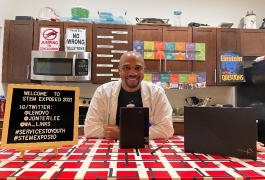The Art Preparing for an Oral Presentation
A research talk may seem like frosting on the cake to the labor of your project, but it is just as important as the days (weeks, months!) spent laboring in the lab. Even the best science can fall into oblivion if it is poorly communicated, so you need to be able to talk effectively about your research.
Short research talks that take less than 15 minutes are in some ways harder to pull off than the hour-long ones found in a weekly seminar. Short talks require careful planning, tight editing, and lots of rehearsal. Unlike a poster session, which allows you to engage directly with your visitors and tailor what you say to what they ask, a talk requires you to distill the essence of your research in a way that is understandable to most people in the audience. Mastering the art of presenting science is a valuable skill that you will need no matter where your career takes you.
Organize your thoughts
Before populating PowerPoint slides, organize your thoughts. This means thinking about the big picture and how your research fits into it. Put yourself into a “less is more” mindset by developing a 25-word summary of your work using everyday language.
“I start by trying to get my students to put together that little elevator speech that answers the questions of ‘What are you doing, and why do you care?’” says Michelle Boucher, a chemistry professor at Utica College in Utica, New York, and chair of the Undergraduate Student Advisory Board (USAB) for the American Chemical Society.
With a focused message in hand, outline the content of your talk. The traditional components of a scientific presentation—introduction, methods, results, and conclusion—offer a logical framework for telling your story.
Start with a very brief overview of your work—that 25 word summary. While it may feel like you are giving away the end of your story, it actually helps engage the audience and gives them a frame of reference for what you will present.
For the introduction, state the problem you are trying to solve, give some background explaining what is currently known, and tell people what motivates your research question. You may be surprised by how much time setting-up your question takes, but don’t cut corners here. Providing this context will help your audience follow the rest of the talk.
The methods section should briefly cover the techniques and study design you used. Assume your audience is familiar with general chemistry techniques, so you just need to tell them which ones you used. But be prepared to go more in-depth if someone asks follow-up questions about your methods at the end of the talk.
For the results, explain what you found, using visualizations of your data as much as possible. Boil the results down to a few key ideas, rather than sharing all of your data with the audience. The more concise and clear the results, the easier the audience can digest them.
For the conclusion section, talk about what your results mean and how they relate to larger issues. Your audience will appreciate a little help in connecting the dots here, given that they may be hearing a dozen presentations that day.
Be sure to leave time for questions. A good presentation can generate a lot of questions from the audience, so leave anywhere from 10% to 25% of your time slot open.
In practice, you may struggle to find a sweet spot between giving enough background, and having enough time to actually talk results. This means you cannot include every aspect of your research. Your advisor can help constrain the scope of your presentation, but make your peace with leaving out some details to keep within the time limit.
“If someone really wants to know more details, they’ll ask a question or they’ll talk to you in the hallway,” Boucher says. “Stick to the big pictures.”
Get your slides together
When designing your slides, think of them as supports for you to touch on as you tell your research story, rather than as a teleprompter. Draft an outline to work from when creating slides. A rule of thumb is to have one slide per 3-6 minutes, but you’ll also want to leave time for questions. Ideally, you will finish drafting your slides at least two weeks before your talk.
Put the main point of a slide in large text at the top. Some slides will be mostly text, but use images, charts, and tables whenever possible. You should use as few words as possible, distilling your points into short phrases. Choose an easy-to-read sans-serif font, maintain the same style for all slides, and use a large font size.
“Human nature is to read the slide, not to listen to people. So make sure slides are very visual and the text is limited,” says Basudeb Bhattacharyya, a lecturer in chemistry at University of Wisconsin, La Crosse, and a USAB member.
Visually rich slides with graphs, images, or schematics are where your work can really shine. A good graph with clearly labeled axes will convey your findings quickly. Schematic drawings may also illustrate ideas more effectively than words.
Proofread your slides, and root out any typos, misspellings, or grammar errors. Though they might seem minor, these mistakes can distract your audience. To be sure you catch mistakes, have a lab mate or mentor read the slides.
Practice—a lot!
Once your slides are ready, get practicing, both alone and with an audience. Practice will not only help you give a clear and conversational talk, but it also helps calm any anxiety about public speaking.
“It’s normal to get nervous in front of crowds, but don’t let it hold you back,” Bhattacharyya says. “You can overcome that with practice.”
Get the timing right. You don’t want to go over time, but speeding through your slides will leave the audience in a daze. “If you’re going to rush through it, no one will get your message,” says Valerie Goss, associate professor of chemistry at Chicago State University and USAB member. “So practice your pace.”
When showing results slides, take time to walk your audience through them. Even if a graph seems basic, say what it depicts (e.g., “the red line shows absolute numbers, the black line percentages”). Then say how the graph fits into your question (e.g., “This shows that increasing temperature did not improve purification”).
If you keep stumbling over certain slides, it might be a sign that they do not fit into the logical flow of your ideas. You may need to redo that slide, or drop it altogether. If you are tempted to apologize for a slide (“I’m sorry this looks busy, but…”), then redesign or delete it.
If you plan to use a laser pointer, practice using it minimally—use it to draw attention to a particular data point. Do not use it to highlight the obvious, like to circle bullet points, that can be distracting. So are unnecessary mannerisms, like stray hand motions, saying “umm”, or rocking back and forth.
Ask lab mates or mentors to be your practice audience. They can coach you through your delivery and give feedback to make your presentation stronger. Remember to practice in front of someone. It’ll help boost your confidence.
Showtime
Look neat and professional for your talk. “Now is not the time for a disheveled look,” Goss says.
If you are feeling nervous at the start of your talk, Goss recommends using the first title slide to introduce yourself: State your name, institution, major, and your professor with whom you did the work. “That will settle the butterflies in your stomach, and help you ground yourself,” she says.
When you finish your talk, pause and say “Thank you” to signal that you’re done. Hopefully someone will ask a question. Try not to think about this as facing a firing squad, but rather as an opportunity to engage in conversation and for feedback. Questions might help you focus future experiments, or help you frame the work when writing up a manuscript. They are also a sign that the audience is interested by your work and presentation!
Always repeat the question, to make sure you understand it and that the audience hears it. If you don’t understand it, ask for clarification. Take a deep breath or a sip of water to give yourself a few seconds to formulate your answer. If you don’t know the answer, say so; no one expects you to know everything. Even better, find out the answer and follow up with the questioner later.
Stick to the facts. The best presentations are the ones that just explain what has been done, Boucher says. “Even if very little worked out well, it can be a very good talk because the speaker was trying something hard, and it was a worthwhile thing to try, and that’s something worth talking about.”




